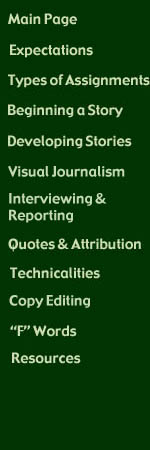

Various Types of Assignments
by Brittany Taylor
(printable version here)
Not every assignment follows these very definite set of instructions. Reporters may be assigned
types of stories that require different considerations from what they first learn and certainly
from the topics covered here. These assignments can include things like straight news, analysis,
editorials, and features.
News
When you scan a newspaper, you’ll see that most of the stories printed on the front page are news stories. News stories are just that: they focus on events of importance to the paper’s audience. News comes in all varieties: local, regional, national and international. There are also niche topics within news writing. For example, you could be a reporter who covers business news, sports news, technology news or fashion news, to name just a few.
To cover news, you must…
1. Be impartial: You need to present all sides of the story fairly. That means that you must interview all of the pertinent parties involved.
2. Be accurate: Because news is based on facts, you have to make sure you get yours right. That means double- and triple-checking statistics, names, dates and other pieces of information.
3. Have good news judgment: Space is precious in newspapers and so brevity is essential. You need to be able to identify what is news and what isn’t news, and you need to be able to decide what your audience needs to know and what it could do without.
4. Never editorialize: News is all fact, no opinion. Remember that!
New stories usually follow a rigid format: A short lede of no more than 30 words followed by an article packed with pertinent information arranged in an inverted pyramid style. No first person. To understand the inverted pyramid style, start by imagining a pyramid. Now flip it upside down. That’s your inverted pyramid. To apply the concept to news, think of the most important details as the widest layer of the pyramid, its foundation. The least important details are at the top. Because people scan the news quickly, it’s essential to put the most important facts and details at the beginning of a story. It also helps editors to cut out less important tidbits to fit an article into the space allotted for it in print.
The best-selling newspapers in the United States include: USA Today, The New York Times, and The Washington Post.
Analysis
More and more frequently, you’ll see newspapers such as The New York Times printing pieces that are not quite news articles, not quite editorials and not quite features (Read on for more about those forms of journalism!). These articles are usually called “news analysis.” They go into more depth than a straight news article, described above, typically would, offering an analysis of events and how it might affect the surrounding area. Pieces like this require a great deal of knowledge about the event, the area in which it takes place and the people involved, and thus are usually written by more experienced reporters who specialize in covering certain areas or topics.
You can find analysis pieces in the newspapers mentioned above, as well as in non-daily publications, like the weekly newsmagazine Time.
Editorials
Editorials are informed opinion pieces and are usually printed on the editorial or op-ed page of a
newspaper. But an editorial isn’t a forum for recklessly spouting off your opinion. You need to
research your topic and present a well-reasoned argument. Because it is your opinion, you’re free
to use first person in your editorial and be persuasive.
Notable editorial columnists include Maureen Dowd, Thomas Friedman, and Nicholas Kristof (all
for The New York Times).
Features
A feature article builds upon the interests of the audience. It opens the door to more creative
approaches to traditional, straight news ledes and inverted pyramid formatting. These stories
focus on people and what they like to do, where they live, what they eat, what entertains them.
The sky is the limit when it comes to features, but when you’re assigned a feature article, you
must make sure that it’s a topic your audience will be interested in.
Features stories include:
1. Profiles of prominent or unique individuals of interest to the community
2. Reviews of books, films, music, restaurants and more
3. Q&A-type interviews
4. Background for certain events or traditions
5. Historical pieces that delve into the past
Publications famous for their feature stories include Vanity Fair, The New Yorker, and The Atlantic.
Other Disciplines | Writer's Web | Writing Center | Make
an Appointment | Library |
Department of Journalism | Copyright Info